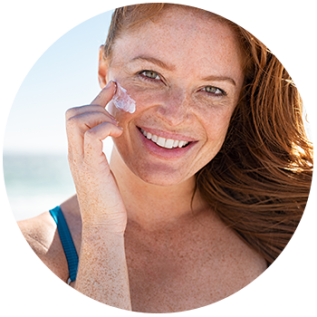
Reviewed by: Kate Shuster, M.D., FAAD, Specialist in Dermatology at Galen Dermatology
Did you know that approximately 9,500 people in the U.S. are diagnosed with skin cancer every day? Skin cancer is a common form of cancer that occurs mostly on skin exposed to the sun. There are three common types of skin cancer – basal cell carcinoma, squamous cell carcinoma, and melanoma.
Skin cancer can present on an individual's scalp, face, lips, ears, neck, chest, arms, hands, and legs. While skin cancer typically develops on skin exposed to the sun, it can still form on skin that rarely sees the sun. Skin cancer can affect people of all skin tones and skin types.
Signs & Symptoms
Skin cancer can present differently in everyone, and each type of skin cancer looks different. Below is a breakdown of signs and symptoms of basal cell carcinoma, squamous cell carcinoma, and melanoma.
Basal Cell Carcinoma – typically occurs in areas of the body that are exposed to sun often, such as the neck or face.
Basal cell carcinoma may present on the skin as
-
A flat, flesh-colored or brown scar like lesion
-
A pearly or waxy bump
-
A bleeding or scabbing sore that heals and then reoccurs.
Squamous Cell Carcinoma – Most often occurs on the face, ears, and hands. Individuals with darker skin tones are more likely to develop squamous cell carcinoma in areas that aren’t usually exposed to the sun.
Squamous cell carcinoma may present on the skin as
-
A firm, red nodule
-
A flat lesion with a scaly, crusted surface
Melanoma – Can develop anywhere on the body where the skin is basically normal or in an already preexisting mole. The most common places where melanoma is found is on the face or the trunk of affected men. Most women typically develop melanoma on their lower legs.
Melanoma may present on the skin as
-
Dark lesions on the palms, soles, fingertips, or toes, or the mucous membranes lining the mouth, nose, vagina, or anus
-
A small lesion with an irregular shape and portions may appear red, pink, white, blue, or blue-black
-
A large semi-brown spot with darker speckles
-
A mole that changes color, size or feel. The mole might even bleed
-
A painful lesion that may itch or burn
Prevention
Everyone knows that spending too much time outside in direct sunlight without using protection can increase the risk of developing skin cancer. Here are some tips to help you prevent skin cancer.
-
Avoid the sun during the middle of the day
-
Wear sunscreen year round
-
Wear protective clothing
-
Avoid tanning beds
-
Be aware of sun-sensitizing medications
-
Check your skin regularly and report changes to your dermatologist
At Galen Dermatology we sell a wide range of sunscreen products that we recommend protecting your skin. Check out the list of sunscreen products we sell below.
-
EltaMD UV Sport Broad-Spectrum SPF 50 (Full Body Sunscreen)
-
EltaMD UV Clear Broad-Spectrum SPF 46 (Facial Sunscreen)
-
EltaMD UV Clear Broad-Spectrum SPF 46 Tinted (Facial Sunscreen)
-
EltaMD UV Elements Broad-Sprectrum SPF 44 Tinted (Facial Sunscreen)
-
SkinCeuticals Physical Fusion UV Defense Sunscreen Tinted (Facial Sunscreen)
Dr. Shuster’s favorite sunscreen to use daily is EltaMD UV Clear Broad-Spectrum SPF 46 Tinted, and for when she is outdoors Dr. Shuster loves the EltaMD UV Sport Broad-Spectrum APF 50.
If you suspect you might have one of these skin cancers, call our office at (423) 954-9017 to schedule a skin exam with one of our board-certified dermatologists. At Galen Dermatology our dermatologists pride themselves on creating an environment that allows our patients to feel comfortable, informed, and cared for.
